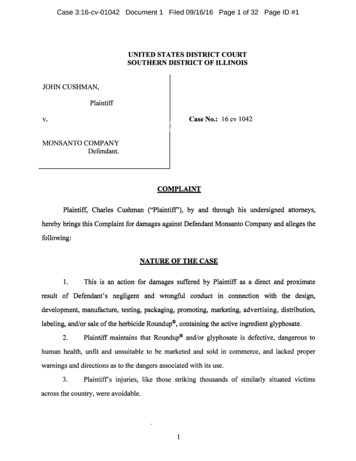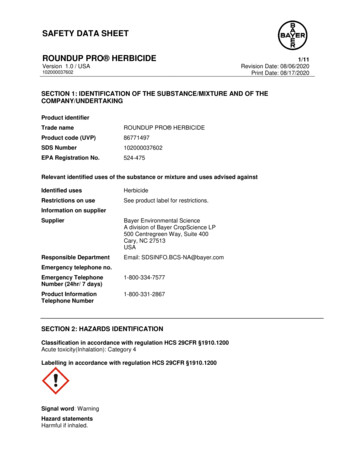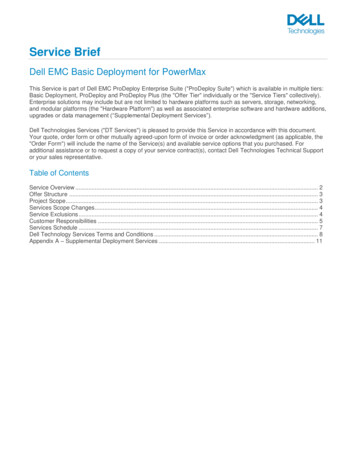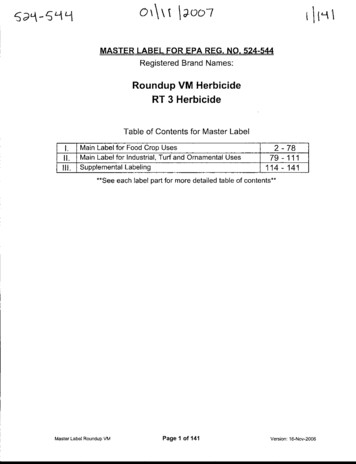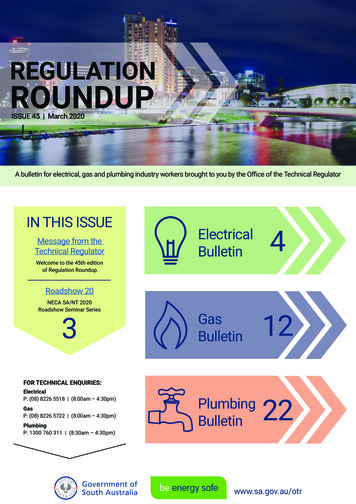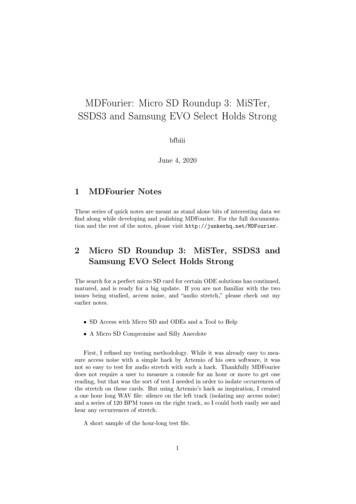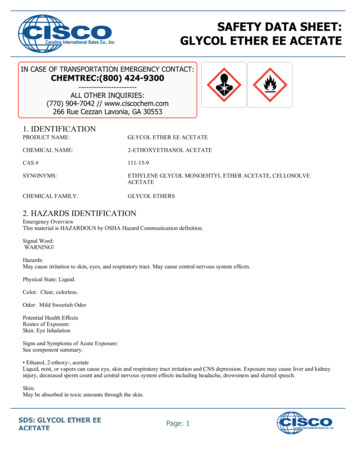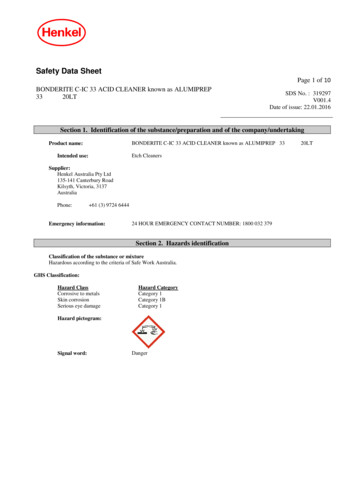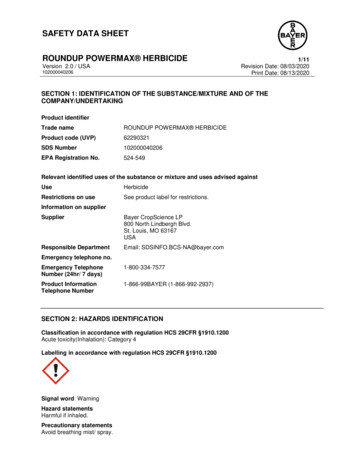
Transcription
SAFETY DATA SHEETROUNDUP POWERMAX HERBICIDEVersion 2.0 / USA1020000402061/11Revision Date: 08/03/2020Print Date: 08/13/2020SECTION 1: IDENTIFICATION OF THE SUBSTANCE/MIXTURE AND OF THECOMPANY/UNDERTAKINGProduct identifierTrade nameROUNDUP POWERMAX HERBICIDEProduct code (UVP)62290321SDS Number102000040206EPA Registration No.524-549Relevant identified uses of the substance or mixture and uses advised againstUseHerbicideRestrictions on useSee product label for restrictions.Information on supplierSupplierBayer CropScience LP800 North Lindbergh Blvd.St. Louis, MO 63167USAResponsible DepartmentEmail: SDSINFO.BCS-NA@bayer.comEmergency telephone no.Emergency TelephoneNumber (24hr/ 7 days)1-800-334-7577Product InformationTelephone Number1-866-99BAYER (1-866-992-2937)SECTION 2: HAZARDS IDENTIFICATIONClassification in accordance with regulation HCS 29CFR §1910.1200Acute toxicity(Inhalation): Category 4Labelling in accordance with regulation HCS 29CFR §1910.1200Signal word: WarningHazard statementsHarmful if inhaled.Precautionary statementsAvoid breathing mist/ spray.
SAFETY DATA SHEETROUNDUP POWERMAX HERBICIDE2/11Revision Date: 08/03/2020Print Date: 08/13/2020Version 2.0 / USA102000040206Use only outdoors or in a well-ventilated area.IF INHALED: Remove person to fresh air and keep comfortable for breathing.Call a POISON CENTER/doctor/physician if you feel unwell.Hazards Not Otherwise Classified (HNOC)No physical hazards not otherwise classified.No health hazards not otherwise classified.SECTION 3: COMPOSITION/INFORMATION ON INGREDIENTSHazardous Component NamePotassium salt of glyphosateAlcohols, C12-16-alkyl ethers, propoxylated, ncentration % by weight48.78.1SECTION 4: FIRST AID MEASURESDescription of first aid measuresGeneral adviceWhen possible, have the product container or label with you whencalling a poison control center or doctor or going for treatment.InhalationMove to fresh air. If person is not breathing, call 911 or an ambulance,then give artificial respiration, preferably mouth-to-mouth if possible.Call a physician or poison control center immediately.Skin contactWash off immediately with plenty of water for at least 15 minutes. Takeoff contaminated clothing and shoes immediately. Get medicalattention if irritation develops and persists.Eye contactHold eye open and rinse slowly and gently with water for 15-20minutes. Remove contact lenses, if present, after the first 5 minutes,then continue rinsing eye. Call a physician or poison control centerimmediately.IngestionCall a physician or poison control center immediately. Rinse out mouthand give water in small sips to drink. DO NOT induce vomiting unlessdirected to do so by a physician or poison control center. Never giveanything by mouth to an unconscious person. Do not leave victimunattended.Most important symptoms and effects, both acute and delayedSymptomsTo date no symptoms are known.Indication of any immediate medical attention and special treatment neededRisksThis product is not a cholinesterase inhibitor.TreatmentTreatment with atropine and oximes is not indicated. Appropriatesupportive and symptomatic treatment as indicated by the patient'scondition is recommended.
SAFETY DATA SHEETROUNDUP POWERMAX HERBICIDEVersion 2.0 / USA1020000402063/11Revision Date: 08/03/2020Print Date: 08/13/2020SECTION 5: FIREFIGHTING MEASURESExtinguishing mediaSuitableUse water spray, alcohol-resistant foam, dry chemical or carbondioxide.UnsuitableHigh volume water jetSpecial hazards arisingfrom the substance ormixtureIn the event of fire the following may be released:, Carbon monoxide(CO), Carbon dioxide (CO2), Nitrogen oxides (NOx), Oxides ofphosphorusAdvice for firefightersSpecial protectiveequipment for firefightersIn the event of fire and/or explosion do not breathe fumes. Firefightersshould wear NIOSH approved self-contained breathing apparatus andfull protective clothing. Equipment should be thoroughlydecontaminated after use.Further informationKeep out of smoke. Fight fire from upwind position. Cool closedcontainers exposed to fire with water spray. Do not allow run-off fromfire fighting to enter drains or water courses.Flash pointdoes not flashAuto-ignition temperatureNo data availableLower explosion limitNot applicableUpper explosion limitNot applicableExplosivityNot explosiveSECTION 6: ACCIDENTAL RELEASE MEASURESPersonal precautions, protective equipment and emergency proceduresPrecautionsUse personal protective equipment. Keep unauthorized people away.Avoid contact with spilled product or contaminated surfaces.Methods and materials for containment and cleaning upMethods for cleaning upSoak up with inert absorbent material (e.g. sand, silica gel, acidbinder, universal binder, sawdust). Collect and transfer the productinto a properly labelled and tightly closed container. Keep in suitable,closed containers for disposal. Clean contaminated floors and objectsthoroughly, observing environmental regulations.Additional adviceUse personal protective equipment. If the product is accidentallyspilled, do not allow to enter soil, waterways or waste water canal. Donot allow product to contact non-target plants.
SAFETY DATA SHEETROUNDUP POWERMAX HERBICIDEVersion 2.0 / USA102000040206Reference to other sections4/11Revision Date: 08/03/2020Print Date: 08/13/2020Information regarding safe handling, see section 7.Information regarding personal protective equipment, see section 8.Information regarding waste disposal, see section 13.SECTION 7: HANDLING AND STORAGEPrecautions for safe handlingAdvice on safe handlingAvoid contact with skin, eyes and clothing. Ensure adequate ventilation.Hygiene measuresWash hands thoroughly with soap and water after handling and beforeeating, drinking, chewing gum, using tobacco, using the toilet orapplying cosmetics.Remove Personal Protective Equipment (PPE) immediately afterhandling this product. Remove soiled clothing immediately and cleanthoroughly before using again. Wash thoroughly and put on cleanclothing. Keep working clothes separately. Garments that cannot becleaned must be destroyed (burnt).Conditions for safe storage, including any incompatibilitiesRequirements for storageareas and containersStore in original container. Store in a cool, dry place and in such amanner as to prevent cross contamination with other crop protectionproducts, fertilizers, food, and feed. Store in a place accessible byauthorized persons only. Reacts with galvanised steel or unlined mildsteel to produce hydrogen, a highly flammable gas that could explode.Protect from freezing. Partial crystallization may occur on prolongedstorage below the minimum storage temperature. Freezing will affect thephysical condition but will not damage the material. Thaw and mixbefore using.Advice on common storageKeep away from food, drink and animal feedingstuffs.SECTION 8: EXPOSURE CONTROLS/PERSONAL PROTECTIONControl parametersNo known occupational limit values.Exposure controlsPersonal protective equipmentIn normal use and handling conditions please refer to the label and/or leaflet. In all other cases thefollowing recommendations would apply.Respiratory protectionWhen respirators are required, select NIOSH approved equipmentbased on actual or potential airborne concentrations and inaccordance with the appropriate regulatory standards and/or industryrecommendations.Hand protectionPlease observe the instructions regarding permeability andbreakthrough time which are provided by the supplier of the gloves.
SAFETY DATA SHEETROUNDUP POWERMAX HERBICIDEVersion 2.0 / USA1020000402065/11Revision Date: 08/03/2020Print Date: 08/13/2020Also take into consideration the specific local conditions under whichthe product is used, such as the danger of cuts, abrasion, and thecontact time.Chemical-resistant gloves (barrier laminate, butyl rubber, nitrilerubber or Viton)Wash gloves when contaminated. Dispose of when contaminatedinside, when perforated or when contamination on the outside cannotbe removed. Wash hands frequently and always before eating,drinking, smoking or using the toilet.Eye protectionUse tightly sealed goggles and face protection.Skin and body protectionWear long-sleeved shirt and long pants and shoes plus socks.General protective measuresFollow manufacturer's instructions for cleaning/maintaining PPE. Ifno such instructions for washables, use detergent and warm/tepidwater.Keep and wash PPE separately from other laundry.SECTION 9. PHYSICAL AND CHEMICAL PROPERTIESInformation on basic physical and chemical propertiesFormLiquid, clearColourlight yellow to light red brownOdourodourlessOdour ThresholdNo data availablepH4.3 - 4.8 (6.77 %) (23 C) (deionized water)Melting point/rangeNo data availableBoiling PointNo data availableFlash pointdoes not flashFlammabilityNo data availableAuto-ignition temperatureNo data availableMinimum ignition energyNot applicableSelf-accelaratingdecomposition temperature(SADT)No data availableUpper explosion limitNot applicableLower explosion limitNot applicableVapour pressureNo significant volatility.Evaporation rateNo data availableRelative vapour densityNo data available
SAFETY DATA SHEETROUNDUP POWERMAX HERBICIDEVersion 2.0 / USA1020000402066/11Revision Date: 08/03/2020Print Date: 08/13/2020Relative density1.3565 (20 C)Water at 15,6 CDensityca. 1.36 g/cm³ (20 C)Water solubilitysolublePartition coefficient: noctanol/waterlog Pow: -3.2 (25 C)The value mentioned relates to the active ingredient glyphosate.Partition coefficient: noctanol/waterPotassium salt of glyphosate: log Pow: -3.2 (25 C)Viscosity, dynamicNo data availableViscosity, kinematicNo data availableOxidizing propertiesNo data availableExplosivityNot explosiveOther informationFurther safety related physical-chemical data are not known.SECTION 10: STABILITY AND REACTIVITYReactivityThermal decompositionStable under normal conditions.Chemical stabilityStable under recommended storage conditions.Possibility of hazardousreactionsReacts with galvanised steel or unlined mild steel to produce hydrogen,a highly flammable gas that could explode.Conditions to avoidExtremes of temperature and direct sunlight.Incompatible materialsGalvanised steel, Carbon steel, Unlined mild steelStore only in the original container.Hazardous decompositionproductsHazardous products of combustion: see section 5.SECTION 11: TOXICOLOGICAL INFORMATIONExposure routesEye contact, Inhalation, Skin contact, IngestionImmediate EffectsEyeMay cause eye irritation.SkinNot expected to produce significant adverse effects whenrecommended use instructions are followed.
SAFETY DATA SHEETROUNDUP POWERMAX HERBICIDE7/11Revision Date: 08/03/2020Print Date: 08/13/2020Version 2.0 / USA102000040206IngestionNot expected to produce significant adverse effects whenrecommended use instructions are followed.InhalationMay be harmful if inhaled.Information on toxicological effectsAcute oral toxicityLD50 (Rat) 5,000 mg/kgTest conducted with a similar formulation.Acute inhalation toxicityLC50 (Rat) 2.58 mg/lExposure time: 4 hDetermined in the form of liquid aerosol.highest concentration testedTest conducted with a similar formulation.Acute dermal toxicityLD50 (Rat) 5,000 mg/kgTest conducted with a similar formulation.Skin corrosion/irritationSlight irritant effect - does not require labelling. (Rabbit)Test conducted with a similar formulation.Serious eye damage/eyeirritationSlight irritant effect - does not require labelling. (Rabbit)Test conducted with a similar formulation.Respiratory or skinsensitisationSkin: Non-sensitizing. (Guinea pig)OECD Test Guideline 406, Buehler testTest conducted with a similar formulation.Assessment STOT Specific target organ toxicity – single exposurePotassium salt of glyphosate: This information is not available.Assessment STOT Specific target organ toxicity – repeated exposurePotassium salt of glyphosate: This information is not available.Assessment mutagenicityPotassium salt of glyphosate is not considered mutagenic.Assessment carcinogenicityPotassium salt of glyphosate: Based on available data, the classification criteria are not met.Important comment to IARC Listing:, Our expert opinion is that classification as a carcinogen is notwarranted.ACGIHNone.NTPNone.IARCPotassium salt of glyphosateOSHANone.70901-12-1Overall evaluation: 2A
SAFETY DATA SHEETROUNDUP POWERMAX HERBICIDEVersion 2.0 / USA1020000402068/11Revision Date: 08/03/2020Print Date: 08/13/2020Assessment toxicity to reproductionPotassium salt of glyphosate: Based on available data, the classification criteria are not met.Assessment developmental toxicityPotassium salt of glyphosate: This information is not available.Aspiration hazardBased on available data, the classification criteria are not met.SECTION 12: ECOLOGICAL INFORMATIONToxicity to fishLC50 (Lepomis macrochirus (Bluegill sunfish)) 5.2 mg/lstatic test; Exposure time: 96 hTest conducted with a similar formulation.LC50 (Cyprinus carpio (Carp)) 4.0 mg/lstatic test; Exposure time: 96 hTest conducted with a similar formulation.Chronic toxicity to fishOncorhynchus mykiss (rainbow trout)flow-through testNOEC: 9.63 mg/lThe value mentioned relates to the active ingredient glyphosate.Toxicity to aquaticinvertebratesEC50 (Daphnia magna (Water flea)) 8.0 mg/l static test; Exposure time:48 hTest conducted with a similar formulation.Chronic toxicity to aquaticinvertebratesEC50 (Daphnia magna (Water flea)): 12.5 mg/lExposure time: 21 dThe value mentioned relates to the active ingredient glyphosate.Toxicity to aquatic plantsEC50 (Raphidocelis subcapitata (freshwater green alga)) 0.46 mg/lstatic test; Exposure time: 72 hTest conducted with a similar formulation.BiodegradabilityPotassium salt of glyphosate:No data availableKocPotassium salt of glyphosate: Koc: 884BioaccumulationPotassium salt of glyphosate: Bioconcentration factor (BCF) 1Mobility in soilPotassium salt of glyphosate: No data availableResults of PBT and vPvB assessmentPBT and
ROUNDUP POWERMAX HERBICIDE 4/11 Version 2.0 / USA Revision Date: 08/03/2020 102000040206 Print Date: 08/13/2020 Reference to other sections Information regarding safe handling, see section 7. Information regarding personal protective equipment, see section 8. Information regarding waste disposal, see section 13. SECTION 7: HANDLING AND STORAGE Precautions for safe
